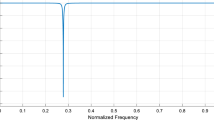Abstract
Powerline contamination of recorded signals represents a major source of noise in electrophysiology and impairs the use of recordings for research. Furthermore it degrades the signal quality and overwhelms tiny features that may be critical for clinical monitoring and diagnosis. During last years, notch filters and adaptive cancellers have been suggested to suppress this interference. In this article we present an improved adaptive canceller for the reduction of the fundamental powerline interference component and harmonics in electrocardiogram (ECG) and electrocardiograph (EEG) recordings. In this new ECG and EEG denoising approach is used an affine projection (AP) algorithm based on Gauss–Seidel method. The results show that the proposed method is able to reduce powerline interference from the noisy ECG and EEG signals more accurately and consistently in comparison to some of the state of-the-art methods. Furthermore, AP can be efficiently used with very low signal-to-noise ratios, while preserving original signal waveform.










Similar content being viewed by others
References
F. Albu, M. Bouchard, Y. Zakharov, Pseudo-affine projection algorithms for multichannel active noise control. IEEE Trans. Audio Speech Lang. Process. 15(3), 1044–1052 (2007)
R. Barrett, M. Berry, T.F. Chan, J. Demmel, J.M. Donato, J. Dongarra, V. Eijkhout, R. Pozo, C. Romine, H.V. der Vorst, Templates for the Solutions of Linear Systems: Building Blocks for Iterative Methods, 2nd edn. (SIAM, Philadelphia, 1994)
M. Bouchard, The gauss-seidel fast affine projection algorithm for multichannel active noise control and sound reproduction systems. IEEE Trans. Speech Audio Process. 11(1), 54–60 (2003)
J. Bronzino, The Biomedical Engineering Handbook, 2nd edn. (CRC Press, Springer, 2000)
T. Degen, H. Jackel, Enhancing interference rejection of preamplified electrodes by automated gain adaption. IEEE Trans. Biomed. Eng. 51(11), 2031–2039 (2004)
A.L. Goldberger, L.A.N. Amaral, L. Glass, J.M. Hausdorff, P.Ch. Ivanov, R.G. Mark, J.E. Mietus, G.B. Moody, C.-K. Peng, H.E. Stanley, PhysioBank, PhysioToolkit, and PhysioNet: Components of a new research resource for complex physiologic signals. Circulation. (2000). 101(23):e215–e220 (June 13). Circulation electronic pages: http://circ.ahajournals.org/cgi/content/full/101/23/e215
P.S. Hamilton, A comparison of adaptive and non-adaptive filters for reduction of power line interference in the ECG. IEEE Trans. Biomed. Eng. 43(1), 105–109 (1996)
S. Haykin, Adaptive Filter Theory, 5th edn. (Prentice-Hall, Englewood Cliffs, 2013)
C.C. Huang, S.F. Liang, M.S. Young, F.Z. Shaw, A novel application of the s-transform in removing powerline interference from biomedical signals. Physiol. Meas. 30(1), 13–27 (2009)
Y.Z. Ider, M.C. Saki, H. Alper Guer, Removal of power line interference in signal-averaged electrocardiography systems. IEEE Trans. Biomed. Eng. 42(7), 731–735 (1995)
E. Laciar, R. Jané, D.H. Brooks, Improved alignment method for noisy high-resolution ecg and holter records using multiscale crosscorrelation. IEEE Trans. Biomed. Eng. 50(3), 344–353 (2003)
J.M. Leski, N. Henzel, ECG baseline wander and powerline interference reduction using non-linear filter bank. Signal Process. 85(4), 781–793 (2005)
W. Li, The convergence of the modified gauss-seidel methods for consistent linear systems. J. Comput. Appl. Math. 154(1), 97–105 (2003)
G. Li, X. Zeng, X. Zhou, Y. Zhou, G. Liu, X. Zhou, Robust suppression of non-stationary power-line interference in electrocardiogram signals. Physiol. Meas. 33(7), 1151–1169 (2012)
G. Luo, Wavelet notch filter design of spread-spectrum communication systems for high-precision wireless positioning. Circ. Syst. Signal Process. 31, 651–668 (2012)
S.M.M. Martens, M. Mischi, S.G. Oei, J.W.M. Bergmans, An improved adaptive power line interference canceller for electrocardiography. IEEE Trans. Biomed. Eng. 53(11), 2220–2231 (2006)
J. Mateo, A. Torres, M.A. García, C. Sánchez, R. Cervigon, Robust volterra filter design for enhancement of electroencephalogram signal processing. Circ. Syst. Signal Process. 32(1), 233–253 (2013)
J. Mateo, A.M. Torres, M.A. García, Dynamic fuzzy neural network based learning algorithms for ocular artefact reduction in eeg recordings. Neural Process. Lett. 39(1), 45–67 (2014)
S. Nikolić, G. Stancić, Design of IIR notch filter with approximately linear phase. Circ. Syst. Signal Process. 31(6), 2119–2131 (2012)
K. Ozeki, T. Umeda, An adaptive filtering algorithm using an orthogonal projection to an affine subspace and its properties. Electron. Commun. Jpn. 67–A, 126–132 (1984)
S.C. Pei, C.C. Tseng, Elimination of AC interference in electrocardiogram using IIR notch filter with transient suppression. IEEE Trans. Biomed. Eng. 42(11), 1128–1132 (1995)
S. Poornachandra, N. Kumaravel, A novel method for the elimination of power line frequency in ECG signal using hyper shrinkage function. Digit. Signal Process. 18(2), 116–126 (2008)
J.G. Proakis, D.G. Manolakis, Digital Signal Processing: Principles, Algorithms and Applications, 3rd edn. (Prentice-Hall, Englewood Cliffs, 1996)
R.M. Rangayyan, Biomedical Signal Analysis: A Case-Study Approach, IEEE Press Series in Biomedical Engineering (IEEE Press, Wiley, 2002)
R. Sameni, M.B. Shamsollahi, C. Jutten, G.D. Clifford, A nonlinear bayesian filtering framework for ECG denoising. IEEE Trans. Biomed. Eng. 54(12), 2172–2185 (2007)
L. Sörnmo, P. Laguna, Bioelectrical Signal Processing in Cardiac and Neurological Applications (Elsevier Academic Press, Amsterdam, 2005)
C.C. Tseng, S.C. Pei, Stable IIR notch fiter design with optimal pole placement. IEEE Trans. Signal Process. 48(11), 2673–2681 (2001)
Y. Wu, R.M. Rangayyan, Y. Zhouc, S.C. Ngd, Filtering electrocardiographic signals using an unbiased and normalized adaptive noise reduction system. Med. Eng. Phys. 31(1), 17–26 (2009)
L. Xu, Cancellation of harmonic interference by baseline shifting of wavelet packet decomposition coefficients. IEEE Trans. Signal Process. 53(1), 222–230 (2005)
A.K. Ziarani, A. Konrad, A nonlinear adaptive method of elimination of power line interferences in ECG signals. IEEE Trans. Biomed. Eng. 49(6), 540–547 (2002)
Acknowledgments
This work was sponsored by University of Castilla-La Mancha, the project PI10/01215 from Instituto de Salud Carlos III and Virgen de la Luz Hospital of Cuenca (Spain).
Author information
Authors and Affiliations
Corresponding author
Rights and permissions
About this article
Cite this article
Torres, A.M., Mateo, J., García, M.A. et al. Cancellation of Powerline Interference from Biomedical Signals Using an Improved Affine Projection Algorithm. Circuits Syst Signal Process 34, 1249–1264 (2015). https://doi.org/10.1007/s00034-014-9890-6
Received:
Revised:
Accepted:
Published:
Issue Date:
DOI: https://doi.org/10.1007/s00034-014-9890-6




